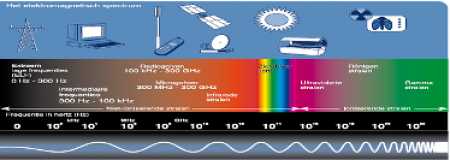Electromagnetic radiation has many forms: gamma rays, x-rays, ultraviolet light, visible light, infrared light, radio waves… These varied forms of radiation are distinguished by the frequency of the electromagnetic wave and the connected energy.
Ionising and non-ionising electromagnetic radiation are also differentiated on the basis of the frequency. The drawing below represents this visually.
Ionising radiation
The most energetic radiation, namely gamma rays, x-rays and a certain part of ultraviolet light, are dangerous for our bodies because they are able to knock electrons out of atoms (ionisation) as a result of their high energy. These forms of radiation are called ionising.
Non-ionising radiation
Less energetic non-ionising radiation – visible light, infrared light and radio waves – are absorbed by our bodies without such pernicious effects. However, it does initiate several biological processes but can only become a risk if it is too strong. Non-ionising is also non-optical radiation such as radio waves and electromagnetic fields of intermediate and extremely low frequency.
As for the non-ionising rays, applications are classified according to frequency:
• Extremely low frequencies (ELF): overhead transmission lines and other electrical facilities, electrical equipment, electric vehicles...
• Intermediate frequencies (IF) or medium frequencies: antitheft and identification systems, energy-efficient bulbs…
• Radiofrequencies (RF) and microwaves : wireless devices, mobile telephones, radio broadcasting, TV, radars,…
This section also discusses the different types of non-ionising radiation and the standardisation thereof. We also discuss questions about electricity, deal with the antitheft protection and energy-efficient bulbs, take a closer look at mobile telephones and wireless devices and give an explanation about electromagnetic hypersensitivity.
For questions about ionising radiation (gamma rays, x-rays) and about the protection of the population or the environment against ionising radiation (radioactive waste, radon, nuclear power plants, etc.) we refer you to the Federal Agency for Nuclear Control (FANC).
You might encounter technical words you do not know when reading this. Please take a look on page “Explanation of used terms”.
Please feel free to consult our brochures about mobile phone and health (in french) "Téléphone mobile et santé" and electromagnetic fields "Champs électromagnétiques" (in french).







